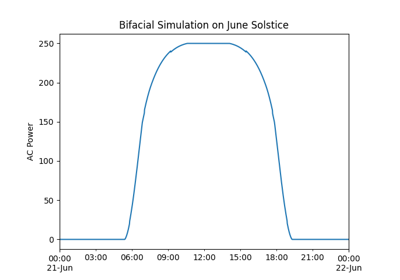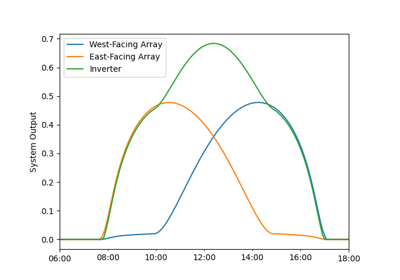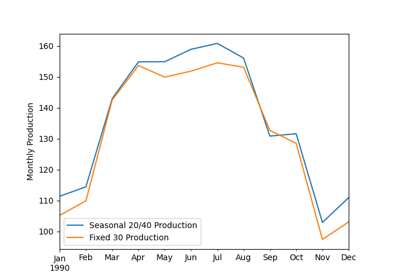pvlib.pvsystem.PVSystem#
- class pvlib.pvsystem.PVSystem(arrays=None, surface_tilt=0, surface_azimuth=180, albedo=None, surface_type=None, module=None, module_type=None, module_parameters=None, temperature_model_parameters=None, modules_per_string=1, strings_per_inverter=1, inverter=None, inverter_parameters=None, racking_model=None, losses_parameters=None, name=None)[source]#
The PVSystem class defines a standard set of PV system attributes and modeling functions. This class describes the collection and interactions of PV system components rather than an installed system on the ground. It is typically used in combination with
LocationandModelChainobjects.The class supports basic system topologies consisting of:
N total modules arranged in series (modules_per_string=N, strings_per_inverter=1).
M total modules arranged in parallel (modules_per_string=1, strings_per_inverter=M).
NxM total modules arranged in M strings of N modules each (modules_per_string=N, strings_per_inverter=M).
The class is complementary to the module-level functions.
The attributes should generally be things that don’t change about the system, such the type of module and the inverter. The instance methods accept arguments for things that do change, such as irradiance and temperature.
- Parameters
arrays (Array or iterable of Array, optional) –
An Array or list of arrays that are part of the system. If not specified a single array is created from the other parameters (e.g. surface_tilt, surface_azimuth). If specified as a list, the list must contain at least one Array; if length of arrays is 0 a ValueError is raised. If arrays is specified the following PVSystem parameters are ignored:
surface_tilt
surface_azimuth
albedo
surface_type
module
module_type
module_parameters
temperature_model_parameters
modules_per_string
strings_per_inverter
surface_tilt (float or array-like, default 0) – Surface tilt angles in decimal degrees. The tilt angle is defined as degrees from horizontal (e.g. surface facing up = 0, surface facing horizon = 90)
surface_azimuth (float or array-like, default 180) – Azimuth angle of the module surface. North=0, East=90, South=180, West=270.
albedo (float, optional) – Ground surface albedo. If not supplied, then
surface_typeis used to look up a value inirradiance.SURFACE_ALBEDOS. Ifsurface_typeis also not supplied then a ground surface albedo of 0.25 is used.surface_type (string, optional) – The ground surface type. See
irradiance.SURFACE_ALBEDOSfor valid values.module (string, optional) – The model name of the modules. May be used to look up the module_parameters dictionary via some other method.
module_type (string, default 'glass_polymer') – Describes the module’s construction. Valid strings are ‘glass_polymer’ and ‘glass_glass’. Used for cell and module temperature calculations.
module_parameters (dict or Series, optional) – Module parameters as defined by the SAPM, CEC, or other.
temperature_model_parameters (dict or Series, optional) – Temperature model parameters as required by one of the models in pvlib.temperature (excluding poa_global, temp_air and wind_speed).
modules_per_string (int or float, default 1) – See system topology discussion above.
strings_per_inverter (int or float, default 1) – See system topology discussion above.
inverter (string, optional) – The model name of the inverters. May be used to look up the inverter_parameters dictionary via some other method.
inverter_parameters (dict or Series, optional) – Inverter parameters as defined by the SAPM, CEC, or other.
racking_model (string, default 'open_rack') – Valid strings are ‘open_rack’, ‘close_mount’, and ‘insulated_back’. Used to identify a parameter set for the SAPM cell temperature model.
losses_parameters (dict or Series, optional) – Losses parameters as defined by PVWatts or other.
name (string, optional) –
**kwargs – Arbitrary keyword arguments. Included for compatibility, but not used.
- Raises
ValueError – If arrays is not None and has length 0.
See also
Methods
__init__([arrays, surface_tilt, ...])calcparams_cec(effective_irradiance, temp_cell)Use the
calcparams_cec()function, the input parameters andself.module_parametersto calculate the module currents and resistances.calcparams_desoto(effective_irradiance, ...)Use the
calcparams_desoto()function, the input parameters andself.module_parametersto calculate the module currents and resistances.calcparams_pvsyst(effective_irradiance, ...)Use the
calcparams_pvsyst()function, the input parameters andself.module_parametersto calculate the module currents and resistances.Calculates the equivalent resistance of the wires for each array using
pvlib.pvsystem.dc_ohms_from_percent()first_solar_spectral_loss(pw, airmass_absolute)Use
pvlib.spectrum.spectral_factor_firstsolar()to calculate the spectral loss modifier.get_ac(model, p_dc[, v_dc])Calculates AC power from p_dc using the inverter model indicated by model and self.inverter_parameters.
get_aoi(solar_zenith, solar_azimuth)Get the angle of incidence on the Array(s) in the system.
get_cell_temperature(poa_global, temp_air, ...)Determine cell temperature using the method specified by
model.get_iam(aoi[, iam_model])Determine the incidence angle modifier using the method specified by
iam_model.get_irradiance(solar_zenith, solar_azimuth, ...)Uses the
irradiance.get_total_irradiance()function to calculate the plane of array irradiance components on the tilted surfaces defined by each array'ssurface_tiltandsurface_azimuth.i_from_v(voltage, photocurrent, ...)Wrapper around the
pvlib.pvsystem.i_from_v()function.pvwatts_dc(g_poa_effective, temp_cell)Calcuates DC power according to the PVWatts model using
pvlib.pvsystem.pvwatts_dc(), self.module_parameters['pdc0'], and self.module_parameters['gamma_pdc'].Calculates DC power losses according the PVwatts model using
pvlib.pvsystem.pvwatts_losses()andself.losses_parameters.sapm(effective_irradiance, temp_cell)Use the
sapm()function, the input parameters, andself.module_parametersto calculate Voc, Isc, Ix, Ixx, Vmp, and Imp.sapm_effective_irradiance(poa_direct, ...[, ...])Use the
sapm_effective_irradiance()function, the input parameters, andself.module_parametersto calculate effective irradiance.sapm_spectral_loss(airmass_absolute)Use the
pvlib.spectrum.spectral_factor_sapm()function, the input parameters, andself.module_parametersto calculate F1.Scales the voltage, current, and power of the data DataFrame by self.modules_per_string and self.strings_per_inverter.
singlediode(photocurrent, ...[, ivcurve_pnts])Wrapper around the
pvlib.pvsystem.singlediode()function.Attributes
num_arraysThe number of Arrays in the system.
Examples using pvlib.pvsystem.PVSystem#

4.7 MW CdTe single-axis tracking (OEDI System 9068)


